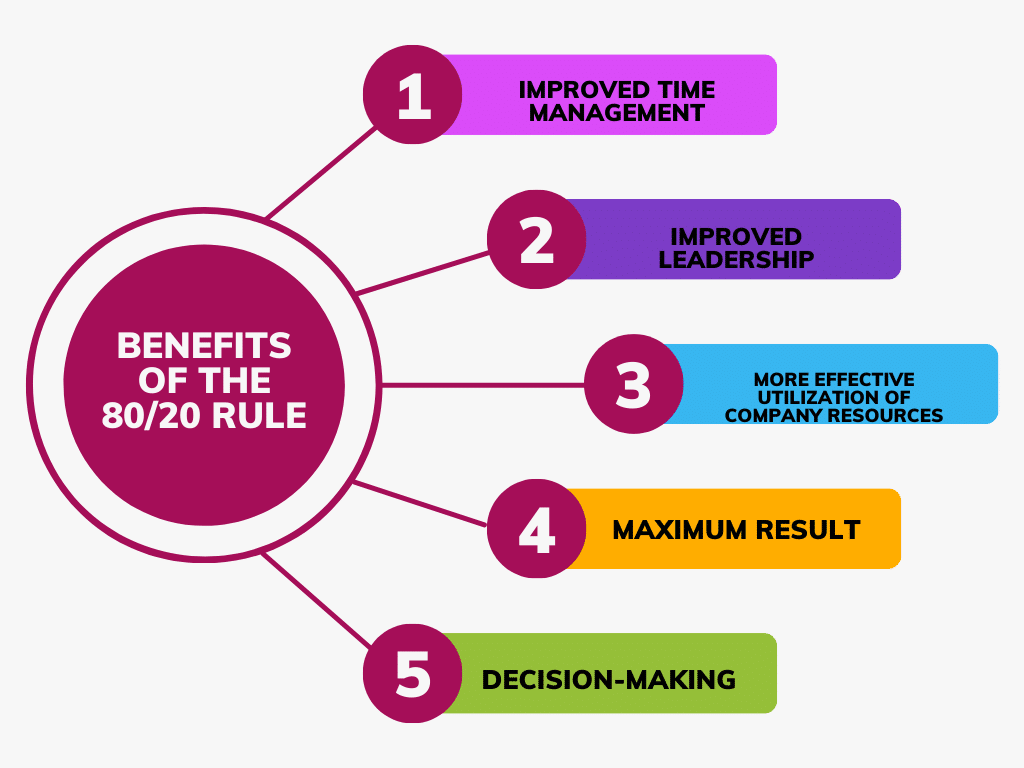Have you at any had that feeling that while working on your business full-time, you’re barely making any progress? I know; I’ve been there. I can assure you that managing a business is hectic. You multitask and are constantly striving to accomplish more with less. It makes sense that for business owners like myself, efficiency is the ultimate goal. What if I told you there’s a secret weapon that can dramatically boost your company’s results and transform the way you manage your workload? The Pareto Principle, sometimes known as the 80/20 rule, is a valuable technique. stay tuned.

History Of The Pareto Principle
Vilfredo Pareto, an Italian economist, observed in the late nineteenth century that 20 percent of his pea plants produced 80 percent of the pea pods in his garden.
Based on his observations, Pareto determined that 20% of the people in Italy held 80% of the country’s wealth. This is a Pareto distribution of wealth.
Although, the name “Pareto Principle” originated by Dr. Joseph Juran, not Pareto. Then Juran adapted Pareto’s observations to his work in operations management in the 1940s. To that effect, he assisted firms in improving production by pointing out that only 20% of manufacturing procedures were responsible for 80% of product faults.
So, using Pareto analysis, he focused on minimizing the 20% of production difficulties to improve production quality.
Juran termed this method the Pareto Principle, and he popularized the idea that to achieve the greatest success, we should focus on the “vital few” while ignoring the “trivial many”.
Key Takeaways
- Understand the significance of the Pareto Principle in business operations, where a small percentage of inputs often yield the majority of results.
- Learn to pinpoint the most impactful tasks, clients, or resources that contribute significantly to your business’s success.
- Focus your efforts on the vital few to maximize efficiency and productivity, allowing you to achieve more with less.
- Streamline processes, delegate tasks, and leverage technology to maximize the impact of your high-value activities.
- Regularly assess the effectiveness of your optimization efforts and adapt your approach as needed.
- Increased productivity, improved resource allocation, cost savings, sharper focus, and reduced stress are a few of the benefits
Understanding What the 80/20 Rule Is

This rule is not some kind of supernatural practice. It’s a profound remark about how cause and effect frequently occur in the actual world. The basic idea is that only 20% of the causes (inputs) account for around 80% of the consequences (outcomes).
Am certain at one point in your life, you’ve encountered in your daily life. Maybe 20% of the content you share generates 80% of your social media engagement. Alternatively, 20% of your customer base may provide for 80% of your sales revenue. This theory applies to many facets of business, which is where things become exciting. But, the question is, what exactly is the 80/20 rule?
The 80-20 rule, commonly known as the Pareto Principle, is a well-known adage that states that for every given event, 80% of the outcomes (or outputs) arise from 20% of the causes (or inputs).
But in business, the 80-20 rule aims to identify and prioritize inputs that have the potential to be the most productive. For example, once managers have identified aspects that are crucial to their company’s performance, they should prioritize them.
Although the 80/20 rule is commonly employed in business and economics, it can be applied to any profession.
Examples of the Pareto Principle
Observing the 80/20 rule in action in real life often helps you grasp how it works better. Here are six circumstances in which you can apply the Pareto Principle.
#1. Pareto Principle In Time Management

Image by pvproductions on Freepik
According to Pareto’s principle, being busy does not imply productivity.
This is why entrepreneurs, small business owners, and self-employed people frequently believe they must work excessive hours to generate profits and avoid working for someone else.
This type of conduct results in a distorted work-life balance, which can be unhealthy, lead to burnout, reduce productivity, and even cause people to abandon goals that seemed so vital at the time.
To escape this cycle, discover the 20 percent of income-generating actions that yield the biggest payoff. This is because it covers both what pays well today and what will give the biggest yields in the future.
The effect, you will have more time for personal enrichment, relaxation, exercise, mental wellness, and relationship building if you use the 80/20 principles to complete your professional tasks.
#2. Pareto Principle In Business Management

Image by rawpixel.com on Freepik
When managing a firm, team, or project, it is feasible that 20% of the work is completed by the remaining 80% of the personnel.
To identify your most productive employees, apply Pareto analysis concepts. Assign them the most vital tasks. Place them in positions of leadership so that they can teach others the same ideas they live by.
Then, examine and question these team members. Identify their distinct characteristics, abilities, and routines that contribute to their productivity. Use this information to train other employees, improving the overall productivity of your team.
#3. Pareto Principle In Goal Setting

Image by rawpixel.com on Freepik
Are you considering applying the Pareto Principle for goal setting? This is a wise decision! Here’s how to apply the Pareto Principle to developing SMART goals that will increase your overall productivity.
Begin by writing five goals on a piece of paper. Then consider: If you could only achieve one of the goals on that list currently, which one would have the largest positive influence on your life?
Then determine the second most critical goal. After completing this activity, you will find that the most significant 20% of your goals will help you the most. You should continue to work at those goals that you’ve chosen as the most valuable of all time.
#4. 80 20 Rule In Problem Solving

Image by gpointstudio on Freepik
Problem-solving is a necessary ability. You must be able to tackle difficulties of all sizes because they are an unavoidable part of our personal and professional lives.
When using the Pareto Principle to solve problems, follow these procedures and use these crucial instruments. You can also create a Pareto diagram to help you visualize the nuances of the problem and discover the potential remedies.
- Create a list of problems you are facing in your situation.
- Determine what is causing each problem, particularly the root cause.
- Give a score to each problem by listing them in order of importance. Those that are impacting your progress the most are the most important ones (the 20 percent) to solve first.
- Organize your list of problems in groups according to those that have the same causes.
- Add up the scores in each group. The group that has the highest score is your highest priority.
- Start brainstorming solutions to this problem group and take action.
#5. 80\ 20 Rule In Sales

Image by creativeart on Freepik
A former colleague of mine is one of the highest-paid commission professionals in the United States. One of his goals was to quadruple his income in the next three to six years, therefore he followed the 80/20 rule with his clientele.
In the process, he discovered that 20% of his clients accounted for 80% of his revenues. He also found that the time spent on a high-profit client was identical to that spent on a low-profit client.
In other words, he was splitting his time equally among the jobs he completed, even though only 20% of those items contributed to 80% of his output.
So he divided his client list into the top 20%, then called in other professionals in his industry and very carefully, respectfully, and strategically gave over the other 80% of his clients, who only accounted for 20% of his revenue.
He then developed a profile of his top clients and began searching the marketplace solely for the type of client who fit the profile; in other words, one who could become a significant profit contributor to his organization and whom he could serve with the same level of excellence that his clients had come to expect. And instead of doubling his income in three to five years, he doubled it in the first year with that one simple time management technique!
How To Apply the 80/20 Rule to Business Optimization

Image source
Now let’s speak about how we can use the 80/20 Rule to improve the way we run our business. One of the first tasks is to identify the critical few—the 20% of inputs that account for 80% of outcomes. This could be evaluating sales data, performing performance assessments, or simply taking a step back to assess how your time and resources are being used. Check out this template too,
For me, this insight came when I evaluated my company’s customer data and learned that a small group of our clients accounted for the majority of our revenue. Instead of spreading ourselves thin and catering to every customer equally, we concentrated our efforts on cultivating those critical relationships, resulting in a large increase in sales. So, how can we utilize the 80/20 rule to change our businesses? Here’s a strategy:
#1. Identify Your High-Impact Zone
Remember when I spent days producing a lovely brochure only to discover that the majority of my customers found me through web ads? That brochure was not in my high-impact 20%! Here’s where the investigative work begins! The first stage is to determine which 20% of your efforts are producing results. Here are some strategies to assist you in discovering your business’s golden nuggets:
- Data Analysis: Numbers don’t lie! Dive into your customer data, sales figures, and website analytics. This will help you identify patterns and pinpoint the areas that are generating the most business for you.
- Track Your Time: How are you actually spending your workday? There are time-tracking apps that can help you see where your minutes (and potentially hours) are going. Are you bogged down in administrative tasks that could be delegated? Identifying your time wasters is key to finding your high-impact activities.
#2. Focus And Optimize
Once you’ve located your golden 20%, it’s time to concentrate your efforts there. In my case, I rebuilt my website and engaged in focused online advertising, which considerably increased my consumer base. Here’s how you can make the most of those golden activities:
- Streamline Processes: Are there repetitive tasks slowing you down? Look for ways to automate or outsource them. Freeing up your time allows you to focus on the high-value activities that move the needle for your business.
- Delegate: You don’t have to be a superhero and do everything yourself. Delegate tasks to capable team members or outsource them to freelancers. This frees you up to focus on your core strengths and strategic initiatives.
#3. Continuous Evaluation and Improvement
The appealing aspect of the 80/20 rule is that it is a continuous process. So, regularly assess the efficacy of your optimization efforts. Are your high-impact areas still producing optimal results? The business scene is continuously changing, so be ready to adjust your strategy as needed. Here’s how to remain ahead of the efficiency game:
- Revisit and Analyze: Regularly evaluate the effectiveness of your optimization efforts. Are your high-impact areas still delivering the best results? The business landscape is constantly changing, so be prepared to adapt your approach as needed.
The Power of 80/20 in Action: Real-World Success Stories
Let me provide a few real-life cases to demonstrate the 80/20 Rule’s effectiveness. Here are a few inspiring instances of how organizations have used the 80/20 rule to produce outstanding results:
#1. Case Study 1: From Perplexed to Optimized
Tech Roofs, a software development company, was drowning in a sea of never-ending projects and deadlines. They followed the 80/20 rule by assessing team activity and determining the 20% that resulted in the most finished projects. In the end, they saw a significant boost in total team productivity after simplifying those duties and eliminating time-wasters.
#2. Case Study 2: Cost-Cutting Leaders
Zlinks Enterprize, a retail chain, was dealing with increasing operational costs. They used the 80/20 rule to manage their inventory, focusing on the 20% of products that earned the most revenue. In turn, they saved a lot of money by managing stock levels and obtaining better agreements with suppliers on those critical commodities.
These are just a few examples that demonstrate the groundbreaking effects of the 80/20 rule when applied to business efficiency.
Challenges and How to Overcome Them: The Path to Efficiency Mastery
Let’s be honest: executing any new plan presents its own set of challenges. Here are some frequent hurdles you may meet with the 80/20 rule, and how to overcome them:
#1. Myth One: This is a Strict 80/20 Split
Don’t get caught up on the specific numbers. The 80/20 rule is a guideline, not an absolute formula. The precise percentages may differ in your firm.
#2. Challenge One: Identifying the Correct 20%
This can be difficult, but data analysis and candid evaluation are your best friends here. Track analytics, solicit feedback from your team and consumers, and be willing to try new things until you’ve identified your highest-impact areas.
#3. Challenge 2: Priority Impairment
It’s tempting to optimize everything at once. Remember, attention is essential. So, begin by addressing the most important issues first, then work your way down the list. Prioritization methods such as the Eisenhower Matrix can aid with these selections.
To be honest, there were times when I became upset with the relatively sluggish pace of following the 80/20 Rule. It might be difficult to let go of work or initiatives to which we have committed time and energy. But believe me when I say that the payoff is well worth it.
Tools and Resources for Implementing the 80/20 Rule
So, how can you begin to apply the 80/20 Rule in your own business? I’ve discovered that simple spreadsheets and old-fashioned brainstorming sessions are frequently sufficient to get started. The good news is that you don’t have to go it alone in this efficiency drive. There are many resources to help you understand the 80/20 rule:
#1.Software and Technology
Use data analysis tools, like as CRM systems or project management software, to uncover patterns and identify high-impact areas. There are other time-tracking apps available to assist you in seeing where your time is going.
#2: Books and Articles
Dive further into the 80/20 rule with resources like Richard Koch’s classic “The 80/20 Principle” or look for practical application advice in web articles like this one.
#3: Workshops and Training Programs
Think about joining workshops or training programs intended expressly to assist organizations use the 80/20 rule for optimization.
Benefits of the 80/20 rule

The 80/20 rule can help you determine where you should devote the bulk of your time, money, or energy. You can also use it to help you identify attainable goals, describe precise actions to achieve them, and stay focused on what has the greatest impact. Here are just a few benefits that the 80/20 rule offers:
#1. Improved Time Management
You can structure your day to focus on tasks that have the greatest influence on your job by finding those that produce the best results. This can improve your performance and help you advance in your career. It can also help you achieve a better work-life balance.
#2. Improved Leadership
If you want to sharpen your leadership skills, employ the 80/20 rule to allocate time for team socialization. The Pareto Principle can also assist you in your role as a workplace mentor. This might help you foster trust and team togetherness.
#3. More Effective Utilization of Company Resources
The 80/20 rule can help you better utilize your organization’s time and energy to perform things like
- Research competitors or industry trends
- Streamline hiring procedures
- Improve company culture
#4. Maximum Result
The main benefit of applying the Pareto principle is that you can make the greatest impact with the least amount of effort. This can help your team operate more effectively while remaining focused on certain projects. The 80/20 rule might help you boost your metrics in less time by prioritizing efforts in the correct sequence.
#5. Decision-Making
The Pareto principle assists you in making the optimal selections during the problem-solving process. When there are multiple causes for a single problem, the Pareto principle helps you select solutions.
What is the 80-20 rule strategy?
A principle of the 80-20 rule is to identify an entity’s best assets and use them efficiently to create maximum value.
How does the 80-20 rule apply to work?
Productivity. You can use the 80/20 rule to prioritize the tasks that you need to get done during the day. The idea is that out of your entire task list, completing 20% of those tasks will result in 80% of the impact you can create for that day.
Where does the 80/20 rule apply?
In the business setting: This principle has been used to evaluate and improve management (when 20% of employees produce 80% of results),
In personal finance: The 80/20 rule is often used to guide budgeting. It directs individuals to put 20% of their monthly income into savings, whether that’s a traditional savings account a brokerage, or a retirement account, to ensure that there’s enough set aside in the event of financial difficulty, and use the remaining 80% as expendable income.
In investing: It’s been found that 20% of a portfolio’s holdings often lead to 80% of its growth. The opposite can also be true, with 80% of investment losses tracing back to 20% of holdings. But, because of the stock market’s unpredictable nature, this rule is often seen as an effective way to evaluate past investments instead of guiding future ones.
Conclusion
Mastering efficiency with the 80/20 Rule is a game-changer in any business. This is because you can increase productivity and profitability by identifying the critical few and focusing your efforts on where they will have the greatest impact.
Remember that Rome was not constructed in a day. Patience, determination, and a willingness to adjust are required while using the 80/20 Rule. So, why not give it a go? Who knows? It could be the secret to take your company to the next level.
References
- .investopedia.com
- asana.com
- .briantracy.com
- blog.hubspot.com
- indeed.com






